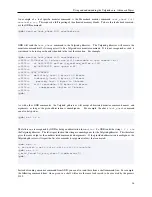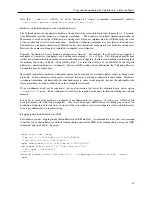
Using and understanding the Valgrind core
The
configure
script tests the version of the X server currently indicated by the current
$DISPLAY
. This is a
known bug. The intention was to detect the version of the current X client libraries, so that correct suppressions could
be selected for them, but instead the test checks the server version. This is just plain wrong.
If you are building a binary package of Valgrind for distribution, please read
README_PACKAGERS
Readme
Packagers
. It contains some important information.
Apart from that, there’s not much excitement here. Let us know if you have build problems.
2.10. If You Have Problems
Contact us at http://www.valgrind.org/.
See
Limitations
for the known limitations of Valgrind, and for a list of programs which are known not to work on it.
All parts of the system make heavy use of assertions and internal self-checks. They are permanently enabled, and we
have no plans to disable them. If one of them breaks, please mail us!
If you get an assertion failure in
m_mallocfree.c
, this may have happened because your program wrote off the
end of a heap block, or before its beginning, thus corrupting heap metadata. Valgrind hopefully will have emitted a
message to that effect before dying in this way.
Read the
Valgrind FAQ
for more advice about common problems, crashes, etc.
2.11. Limitations
The following list of limitations seems long. However, most programs actually work fine.
Valgrind will run programs on the supported platforms subject to the following constraints:
• On x86 and amd64, there is no support for 3DNow! instructions. If the translator encounters these, Valgrind will
generate a SIGILL when the instruction is executed. Apart from that, on x86 and amd64, essentially all instructions
are supported, up to and including AVX and AES in 64-bit mode and SSSE3 in 32-bit mode. 32-bit mode does in
fact support the bare minimum SSE4 instructions to needed to run programs on MacOSX 10.6 on 32-bit targets.
• On ppc32 and ppc64, almost all integer, floating point and Altivec instructions are supported. Specifically: integer
and FP insns that are mandatory for PowerPC, the "General-purpose optional" group (fsqrt, fsqrts, stfiwx), the
"Graphics optional" group (fre, fres, frsqrte, frsqrtes), and the Altivec (also known as VMX) SIMD instruction
set, are supported.
Also, instructions from the Power ISA 2.05 specification, as present in POWER6 CPUs, are
supported.
• On ARM, essentially the entire ARMv7-A instruction set is supported, in both ARM and Thumb mode. ThumbEE
and Jazelle are not supported. NEON, VFPv3 and ARMv6 media support is fairly complete.
• If your program does its own memory management, rather than using malloc/new/free/delete, it should still work,
but Memcheck’s error checking won’t be so effective.
If you describe your program’s memory management
scheme using "client requests" (see
The Client Request mechanism
), Memcheck can do better. Nevertheless, using
malloc/new and free/delete is still the best approach.
• Valgrind’s signal simulation is not as robust as it could be. Basic POSIX-compliant sigaction and sigprocmask
functionality is supplied, but it’s conceivable that things could go badly awry if you do weird things with signals.
Workaround: don’t. Programs that do non-POSIX signal tricks are in any case inherently unportable, so should be
avoided if possible.
24
Содержание BBV
Страница 176: ...Valgrind FAQ Release 3 8 0 10 August 2012 Copyright 2000 2012 Valgrind Developers Email valgrind valgrind org ...
Страница 177: ...Valgrind FAQ Table of Contents Valgrind Frequently Asked Questions 1 ii ...
Страница 302: ...README mips based on newer GCC versions if possible 95 ...
Страница 303: ...GNU Licenses ...
Страница 304: ...GNU Licenses Table of Contents 1 The GNU General Public License 1 2 The GNU Free Documentation License 8 ii ...
















































